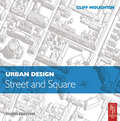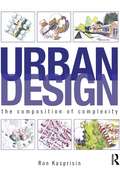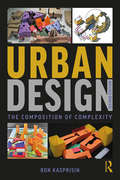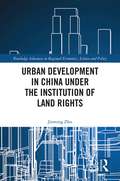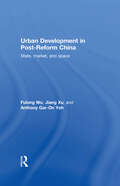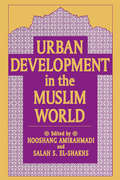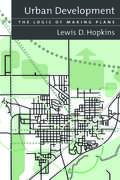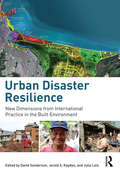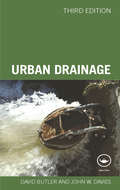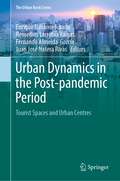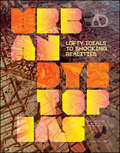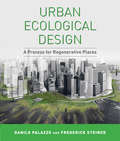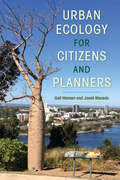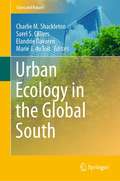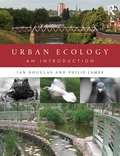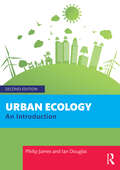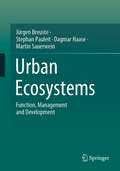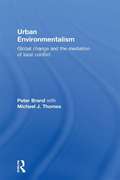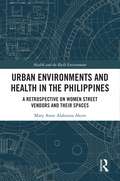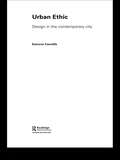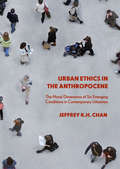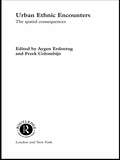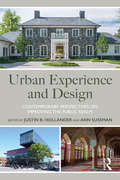- Table View
- List View
Urban Design: Street And Square (Urban Design Ser.)
by Cliff MoughtinThis book, part of a series of four, offers a detailed analysis of urban design, covering the streets, squares and buildings that make up the public face of towns and cities. It outlines the theory of the principal features of urban design from which method is developed and provides a better understanding of the main elements of urban design. This includes the arrangement, design and details of the streets and squares, and the roles they play in city planning.This third edition includes chapters on "Sustainable Urban Design" and "Visual Analysis", introducing the latest theories and influences in the field and bringing greater practical significance to the book. Cliff Moughtin explores the street and square in terms of function, structure and symbolism and examines fine examples in their historical context. These are set against the background of the laws of urban design composition, culled from Renaissance and modern writers.
Urban Design: The Composition of Complexity
by Ron KasprisinFor planning to be successful, design must mean more than simply blindly following the dictates of legislation and regulation – yet losing sight of the importance of the design process is all too often exactly what has happened. Ron Kasprisin has written a book for students of planning and urban design that reconnects the process of designing with outcomes on the ground, and puts thinking about design back at the heart of what planners do. The book identifies the elements and principles of composition and explores compositional order and structure as they relate to the meaning and functionality of cities. It discusses new directions and methods, outlines the importance of both buildings and the open spaces between them. Mixing accessible theory, practical examples and carefully designed exercises in composition from simple to complex settings, Urban Design is an essential textbook for classrooms and design studios across the full spectrum of planning and urban studies fields. Not only filled with illustrations and graphics of excellent projects, it gives students tools to enable them to sketch, draw, design and above all, to think.
Urban Design: The Composition of Complexity
by Ron KasprisinUrban design is a process of establishing a structural order within human settlements; responding to dynamic emergent meanings and functions in a constant state of flux. The planning/design process is complex due to the myriad of on-going (urban) organizational and structural relationships and contexts. This book reconnects the process with outcomes on the ground, and puts thinking about design back at the heart of what planners do. Mixing accessible theory, practical examples, and carefully designed exercises in composition from simple to complex settings, Urban Design is an essential textbook for classrooms and design studios across the full spectrum of planning and urban studies fields. Filled with color illustrations and graphics of excellent projects, it gives students tools to enable them to sketch, draw, design, and above all, to think. This new edition remains focused on instructing the student, professional and layperson in the elements and principles of design composition so that they can diverge from conventional and packaged solutions in pursuit of a meaningful and creative urbanism. This edition builds upon established design principles and encourages the student in creative ways to depart from them as appropriate in dealing with the complexity of culture, space and time dynamics of cities. The book identifies the elements and principles of compositions and explores compositional order and structure as they relate to the meaning and functionality of cities. It discusses new directions and methods, and outlines the importance of both buildings and the open spaces between them.
Urban Development in China under the Institution of Land Rights (Routledge Advances in Regional Economics, Science and Policy)
by Jieming ZhuHow have the development and redevelopment of China’s cities since the early 1950s transformed the settlements and fortunes of a fifth of the world’s population? Rapid urbanization since the 1980s has changed the nation from a rural society to an urban one, marking it as one of the most significant transformations in history. As a country with severe land scarcity, land resources are intensively contested for during urbanization under the new regime of marketization. This book focuses on the impact of the institution of land rights that have transitioned from private ownership to socialist state ownership, and subsequently to public land leasing in the urban domain, and to collective ownership in rural areas. In the context of defining the relationship between the state and the market, the gradualist transition of land rights gives rise to intriguing processes of place-making. The elaboration of these processes will engage several revealing conceptual notions: land as a means of production, land commodification, ambiguous land rights, incomplete land rights, trading land use rights for land development rights, institutional uncertainty, land rent seeking and dissipating, local developmental state, danwei-enterprises, and more. The newly created landed interests are embedded intricately within the urban spatial structure. This book would especially be of interest to scholars interested in developmental economics, urban planning, geography, public policies, public management, and sociology, and also practitioners focusing on development and planning.
Urban Development in Post-Reform China: State, Market, and Space
by Fulong Wu Jiang Xu Anthony Gar-On YehRadically reoriented under market reform, Chinese cities present both the landscapes of the First and Third World, and are increasingly playing a critical role in the country’s economic development. Yet, radical marketization co-exists with the ever-presence of state control. Exploring the interaction of China’s market development, state regulation and the resulting transformation and creation of new urban spaces, this innovative, key book provides the first integrated treatment of China’s urban development in the dynamic market transition. Focusing on land and housing development, the authors, all renowned authorities in this field, show how the market has been ‘created’ under post-reform urban conditions, and examine ‘the state in action’, highlighting how changing urban governance towards local entrepreneurial state facilitates market formation. A significant, original contribution, they highlight the key actors and their institutional contexts. China has been very successful in using urban land development as an economic growth engine, and here the authors investigate complex interactions between the market and state in creating this new urbanism. Taking a unique perspective, they marshal original ideas and empirical work based on field studies and collaborative work with colleagues in China.
Urban Development in the Muslim World
by HOOSHANG AMIRAHMADI and SALAH S. EL-SHAKHSWar and revolution have focused the world's attention on the Middle East. Despite the headlines, the editors of this book state, the economic, political, and cultural aspects of urban life in the Muslim world are hardly known to us. Contributors to this volume explore urban problems, urban development, and the practice of urban planning in the Muslim world.In both comprehensive analyses and detailed case studies, the contributors address the basic dilemma of development planning: how to integrate the force of tradition with the demands of modernity. Specifically, some of the topics covered include the examination of the idea of a uniquely Islamic city; the influence of Islam on the medinas of Tunisia and Morocco and on the development of Mecca and Delhi; and reconciling tradition and modernism in Tehran.Also covered are the comparative development of Sana'a and Cairo; the influence of oil on urbanization in the Persian Gulf; urban growth in Syria; and an overview of urban planning in the Arab world. This compendium is essential for specialists and students of the region, for international planning and development practitioners, and for those seeking insight into the complexities of this important but arguably least understood region of the world.
Urban Development: The Logic Of Making Plans
by Lewis D. HopkinsWith increased awareness of the role of plans in shaping urban and suburban landscapes has come increased criticism of planners and the planning profession. Developers, politicians, and citizens alike blame "poor planning" for a host of community ills. But what are plans really supposed to do? How do they work? What problems can they successfully address, and what is beyond their scope? In Urban Development, leading planning scholar Lewis Hopkins tackles these thorny issues as he explains the logic of plans for urban development and justifies prescriptions about when and how to make them. He explores the concepts behind plans, some that are widely accepted but seldom examined, and others that modify conventional wisdom about the use and usefulness of plans. The book: places the role of plans and planners within the complex system of urban development offers examples from the history of plans and planning discusses when plans should be made (and when they should not be made) gives a realistic idea of what can be expected from plans examines ways of gauging the success or failure of plansThe author supports his explanations with graphics, case examples, and hypothetical illustrations that enliven, clarify, and make concrete the discussions of how decisions about plans are and should be made.Urban Development will give all those involved with planning human settlements a more thorough understanding of why and how plans are made, enabling them to make better choices about using and making plans. It is an important contribution that will be essential for students and faculty in planning theory, land use planning, and planning project courses.
Urban Disaster Resilience: New Dimensions from International Practice in the Built Environment
by David Sanderson Jerold S. Kayden Julia LeisAccelerating urbanization worldwide means more urban-centered disasters. Floods, earthquakes, storms and conflicts affecting densely populated areas produce significant losses in lives, livelihoods and the built environment, especially in comparison to rural areas. Poor urban dwellers, almost always the most vulnerable, too often bear the brunt. Aid agencies and urban professionals have been slowly adapting to these new conditions, but older models and practices hinder the most effective engagements. Drawing directly from the experiences of urban disasters in the Philippines, Chile, India, Thailand, Iraq, Haiti and Nepal, among other countries, Urban Disaster Resilience brings to light new collaborations and techniques for addressing the challenges of urban disasters in the coming years. Chapters range from country-specific case studies to more synthetic frameworks in order to promote innovative thinking and practical solutions. Edited by David Sanderson, Jerold S. Kayden and Julia Leis, this book is a crucial read for humanitarian and disaster specialists, urban planners and designers, architects, landscape architects, housing and economic development professionals, real estate developers, private business managers and students interested in the subject, whether based in non-governmental organizations, local, state or national governments, international agencies, private firms, or the academy.
Urban Drainage, Third Edition
by John Davies David ButlerUrban Drainage has been thoroughly revised and updated to reflect changes in the practice and priorities of urban drainage. New and expanded coverage includes: Sewer flooding The impact of climate change Flooding models The move towards sustainability Providing a descriptive overview of the issues involved as well as the engineering principles and analysis, it draws on real-world examples as well as models to support and demonstrate the key issues facing engineers dealing with drainage issues. It also deals with both the design of new drainage systems and the analysis and upgrading of existing infrastructure. This is a unique and essential textbook for students of water, environmental, and public health engineering as well as a valuable resource for practising engineers.
Urban Drama
by J. Chris WestgateIdentifying an apprehension about the nature and constitution of urbanism in North American plays, Westgate examines how cities like New York City and Los Angeles became focal points for identity politics and social justice at the end of the twentieth century, and how urban crises inform the dramaturgy of contemporary playwrights.
Urban Dynamics in the Post-pandemic Period: Tourist Spaces and Urban Centres (The Urban Book Series)
by Enrique Navarro-Jurado Remedios Larrubia Vargas Fernando Almeida-García Juan José Natera RivasThis book offers a unique perspective on urban processes affecting tourist spaces and city centres. Economic, social and environmental uncertainty has been commonplace since March 2019, when mobility slowed down across the globe. The COVID-19 pandemic accelerated trends that have been investigated in urban space for years. The incorporation of technologies, the expansion of tourism and the introduction of policies that in part want to advance sustainability are generating processes of reorganisation of territories that are driving changes. These changes will affect models of city, urbanism and society.This publication is directed to a wide spectrum of people interested in urban processes, tourism and social change in the context of the Post-Pandemic Covid-19. In particular, the book is aimed at researchers, undergraduate and postgraduate students, consultants, public administrations and the public interested in the recent challenges that are affecting developed and developing societies.
Urban Dystopias: Lofty Ideals to Shocking Realities (Architectural Design)
by Jane Burry Marcus WhiteGuest-edited by Marcus White and Jane Burry Cities are facing several coinciding global crises. There is the dominant existential narrative of the impact of and adaptation to climate change, itself powered by cities. In a time of unprecedented urbanisation and growth, resilient architecture and urbanism is needed in response. New modes of transport, renewed anxiety about robots taking jobs, AI, and the humbling recent experience of a global pandemic are all challenging norms and expectations. All of these are forces of social division, all are changing life experience, evoking strong-arm politics, and giving a sense of teetering between radically different possible futures. This is a story about reclaiming the urban design narrative and being alert to the potential impacts of socio-technical decision-making and design in cities. It is a story for its time. The issue explores the dichotomy of idealised visions for the design of urban settlements and the potentially shocking realities that may emerge from the same impulses and intentions. It examines the slippery territory between utopias and some of the ensuing dystopias that may unfold. Contributors: Tridib Banerjee, Daniele Belleri and Carlo Ratti, Steve Glackin, Justyna Karakiewicz, Nano Langenheim and Kongjian Yu, Mehrnoush Latifi, Andong Lu, Dan Nyandega, Jordi Oliveras, Kas Oosterhuis, Claudia Pasquero and Marco Poletto, Ian Woodcock, and Tianyi Yang. Featured architects: Carlo Ratti Associati, ecoLogicStudio, Harrison and White, Turenscape, and Anton Markus Pasing, Remote Control Studio.
Urban Ecological Design: A Process for Regenerative Places
by Danilo Palazzo Frederick R. SteinerThis trailblazing book outlines an interdisciplinary "process model" for urban design that has been developed and tested over time. Its goal is not to explain how to design a specific city precinct or public space, but to describe useful steps to approach the transformation of urban spaces. Urban Ecological Design illustrates the different stages in which the process is organized, using theories, techniques, images, and case studies. In essence, it presents a "how-to" method to transform the urban landscape that is thoroughly informed by theory and practice. The authors note that urban design is viewed as an interface between different disciplines. They describe the field as "peacefully overrun, invaded, and occupied" by city planners, architects, engineers, and landscape architects (with developers and politicians frequently joining in). They suggest that environmental concerns demand the consideration of ecology and sustainability issues in urban design. It is, after all, the urban designer who helps to orchestrate human relationships with other living organisms in the built environment. The overall objective of the book is to reinforce the role of the urban designer as an honest broker and promoter of design processes and as an active agent of social creativity in the production of the public realm.
Urban Ecology for Citizens and Planners
by Gail Hansen Joseli MacedoIdeal for city residents, developers, designers, and officials looking for ways to bring urban environments into harmony with the natural world and make cities more sustainable, Urban Ecology for Citizens and Planners offers a wealth of information and examples that will answer fundamental scientific questions, guide green initiatives, and inform environmental policies and decision-making processes. This book provides an overview of the synergistic relationships between humans and nature that shape the ecology of urban green spaces. It also emphasizes the social and cultural value of nature in cities for human health and well-being. Chapters describe the basic science of natural components and ecosystems in urban areas and explore the idea of biophilic urbanism, the philosophy of building nature into the framework of cities. To illustrate these topics, chapters include projects, case studies, expert insights, and successful citizen science programs from urban areas around the world. Authors Gail Hansen and Joseli Macedo argue that citizens have increasingly important roles to play in the environmental future of the cities they live in. A valuable resource for real-world solutions, this volume encourages citizens and planners to actively engage and collaborate in improving their communities and quality of life.
Urban Ecology in the Global South (Cities and Nature)
by Charlie M. Shackleton Sarel S. Cilliers Elandrie Davoren Marié J. du ToitAgainst the background of unprecedented rates of urbanisation in the Global South, leading to massive social, economic and environmental transformations, this book engages with the dire need to understand the ecology of such settings as the foundation for fostering sustainable and resilient human settlements in contexts that are very different to the Global North. It does so by bringing together scholars from around the world, drawing together research and case studies from across the Global South to illustrate, in an interdisciplinary and comprehensive fashion, the ecology of towns and cities in the Global South. Framed using a social-ecological systems lens, it provides the reader with an in-depth analysis and understanding of the ecological dynamics and ecosystem services and disservices within the complex and rapidly changing towns and cities of the Global South, a region with currently scarce representation in most of the urban ecology literature. As such the book makes a call for greater geographical balance in urban ecology research leading towards a more global understanding and frameworks. The book embraces the complexity of these rapid transformations for ecological and environmental management and how the ecosystems and the benefits they provide shape local ecologies, livelihood opportunities and human wellbeing, and how such knowledge can be mobilised towards improved urban design and management and thus urban sustainability.
Urban Ecology: An Introduction
by Ian Douglas Philip JamesUrban Ecology: An Introduction seeks to open the reader’s mind and eyes to the way in which nature permeates everyday urban living, and how it has to be understood, cared for, and managed in order to make our towns and cities healthier places to visit and in which to live and work. The authors examine how nature can improve our physical and mental health, the air we breathe and the waters we use, as well as boosting our enjoyment of parks and gardens. Urban Ecology sets out the science that underlies the changing natural scene and the tools used to ensure that cities become both capable of adapting to climate change and more beautiful and resilient. The book begins with a discussion of the nature of urban places and the role of nature in towns and cities. Part 1 looks at the context and content of urban ecology, its relationship to other foci of interest within ecology and other environmental sciences, and the character of city landscapes and ecosystems. In Part 2 the authors set out the physical and chemical components of urban ecosystems and ecological processes, including urban weather and climate, urban geomorphology and soils, urban hydrology and urban biogeochemical cycles. In Part 3 urban habitats, urban flora and fauna, and the effects of, deliberate and inadvertent human action on urban biota are examined. Part 4 contains an exploration of the identification and assessment of ecosystem services in urban areas, emphasising economic evaluation, the importance of urban nature for human health and well-being, and restoration ecology and creative conservation. Finally, in Part 5 the tasks for urban ecologists in optimising and sustaining urban ecosystems, providing for nature in cities, adapting to climate change and in developing the urban future in a more sustainable manner are set out. Within the 16 chapters of the book – in which examples from around the world are drawn upon - the authors explore current practice and future alternatives, set out procedures for ecological assessment and evaluation, suggest student activities and discussion topics, provide recommended reading and an extensive bibliography. The book contains more than 150 tables and over 150 photographs and diagrams.
Urban Ecology: An Introduction
by Ian Douglas Philip JamesThis fully revised second edition reflects the great expansion in urban ecology research, action, and teaching since 2015. Urban ecology provides an understanding of urban ecosystems and uses nature-based techniques to enhance habitats and alleviate poor environmental conditions. Already the home to the majority of the world’s people, urban areas continue to grow, causing ecological changes throughout the world. To help students of all professions caring for urban areas and the people, animals, and plants that live in them, the authors set out the environmental and ecological science of cities, linkages between urban nature and human health, urban food production in cities, and how we can value urban nature. The authors explore our responsibilities for urban nature and greening, ecological management techniques, and the use of nature-based solutions to achieve a better, more sustainable urban future and ensure that cities can climate change and become more beautiful and more sustainable places in which to live. This text provides the student and the practitioner with a critical scientific overview of urban ecology that will be a key source of data and ideas for studies and for sound urban management.
Urban Ecosystems: Function, Management and Development
by Stephan Pauleit Dagmar Haase Jürgen Breuste Martin SauerweinThis textbook on urban ecosystems answers important questions about the ecological structure, functions and socio-ecological development of cities worldwide. Based on how cities are developing today in an increasingly urbanized world, it explains ecological challenges for cities of the 21st century such as resource efficiency, climate change, moderation of quality of life and resilience. The book combines theories of urban development and ecology with practical applications and case studies, thus identifying potential for improvement and examples of good ecological urban development worldwide. It shows that cities are by far not only problem areas but also offer great potential for a good life and that the various urban ecosystems can make a considerable contribution to this. The "eco-city" is thus not a utopia,but a real goal that can be pursued step by step in a targeted manner, taking into account the local and regional context.Four renowned urban ecologists have contributed their specific experience in sub-areas without losing sight of the big picture. Jürgen Breuste is an urban ecologist and works at the Paris Lodron University in Salzburg, Austria, on the topics of sustainable urban development, urban biodiversity, ecosystem services and eco-cities. Dagmar Haase is Landschaftsökologin and works at the Humboldt University of Berlin on urban ecosystem services and land use modeling. Stephan Pauleit is a landscape planner and works at the Technical University of Munich on strategies for the sustainable development of urban landscapes. Martin Sauerwein is a geographer and works at the University of Hildesheim on geo-ecology in cultural landscapes, geoarchaeology and soil protection.The textbook addresses a broad audience of students, teachersand also to practitioners in the fields of ecology, urban ecology, urban development, sustainability, urban geography, nature and landscape conservation, spatial planning, landscape ecology, social sciences and urban studies. The numerous photos and graphics, many of them in four colors, as well as clear tables illustrate the facts. Case studies, examples and explanations allow a deeper insight. Questions at the end of each chapter allow the progress of knowledge to be checked, and a comprehensive bibliography for each chapter provides further studies.This book is a translation of the original German 1st edition Stadtökosysteme by Jürgen Breuste published by Springer Fachmedien Wiesbaden GmbH, part of Springer Nature in 2016. The translation was done with the help of artificial intelligence (machine translation by the service DeepL.com). A subsequent human revision was done primarily in terms of content, so that the book will read stylistically differently from a conventional translation. Springer Nature works continuously to further the development of tools for the production of books and on the related technologies to support the authors.This springer essential is a translation of the original German 1st edition essentials,Stadtökosysteme by Jürgen Breuste published by Springer Fachmedien Wiesbaden GmbH, part of Springer Nature in 2016. The translation was done with the help of artificial intelligence (machine translation by the service DeepL.com). A subsequent human revision was done primarily in terms of content, so that the book will read stylistically differently from a conventional translation. Springer Nature works continuously to further the development of tools for the production of books and on the related technologies to support the authors.
Urban Environmentalism: Global Change and the Mediation of Local Conflict
by Michael Thomas Peter BrandA critical examination of urban policies and management practices used to make cities sustainable. With an international perspective, the book describes urban environmental agendas and how they arose in the context of globalization, urban economic restructuring, and the need to make cities competitive. It argues that the environment became an integral part of city development policy, turning attention not only to physical and ecological issues but also to improving the economic performance of cities and the lives of citizens. The authors also go beyond the technical issues to explore the political importance of urban environmentalism, using case studies to illustrate both its international scope and place-specific characteristics which are inexorably influencing city development throughout the world. In connecting the concept to its political effects, the book raises issues such as local democracy, equality and social regulation, all of which are increasingly concerning academics, professionals, environmentalists and city authorities alike.
Urban Environments and Health in the Philippines: A Retrospective on Women Street Vendors and their Spaces (Health and the Built Environment)
by Mary Anne AkersUrban Environments and Health in the Philippines offers a retrospective view of women street vendors and their urban environments in Baguio City, designed by American architect and planner Daniel Burnham in the early twentieth century, and established by the American imperial government as a place for healing and well-being. Based on a transdisciplinary multi-method study of street vendors, the author offers a unique perspective as a researcher of the place, to ultimately ask how marginalized women authenticate and democratize prime urban spaces for their livelihoods. This book provides a portal to another way of seeing and understanding streets and people, covering spatial units at multiple scales, design imperialism and its impact on health, and resilience strategies for challenging realities. Blending subjects of architecture, planning, and health, this book is an ideal read for those interested in fields of urban planning and design, public health, landscape architecture, geography, and social sciences.
Urban Ethic: Design in the Contemporary City
by Eamonn CanniffeAlthough contemporary practice in urbanism has many sources of design guidelines, it lacks theory to provide a flexible approach to the complexities of most urban situations. The author provides that theoretical framework, looking beyond the style obsession of urban makeovers to the fundamental elements of city-making. The scope of this book takes in illuminating historical analysis and significant theoretical coherence, while recent case studies link the physical environment to the citizens within it, ultimately offering a new methodology for the analysis and design of urban spaces which encourages a balance between diversity and community.
Urban Ethics in the Anthropocene: The Moral Dimensions of Six Emerging Conditions in Contemporary Urbanism
by Jeffrey K.H. ChanIncreasingly, we live in an environment of our own making: a ‘world as design’ over the natural world. For more than half of the global population, this environment is also thoroughly urban. But what does a global urban condition mean for the human condition? How does the design of the city and the urban process, in response to the issues and challenges of the Anthropocene, produce new ethical categories, shape new moral identities and relations, and bring about consequences that are also morally significant? In other words, how does the urban shape the ethical—and in what ways? Conversely, how can ethics reveal relations and realities of the urban that often go unnoticed? This book marks the first systematic study of the city through the ethical perspective in the context of the Anthropocene. Six emergent urban conditions are examined, namely, precarity, propinquity, conflict, serendipity, fear and the urban commons.
Urban Ethnic Encounters: The Spatial Consequences (Routledge Research in Population and Migration #5)
by Aygen Erdentug Freek ColombijnUrban Ehtnic Encounters attempts to answer the two leading questions of how urban space structures the life of ethnic groups and how ethnic diversity helps to shape urban space. A multidisciplinary team of authors searches the various dimensions of the spatial organization of inter-ethnic relations in cities and countries around the globe. Unlike most ethnographies in which authors write about the 'other' in faraway places, the majority of the contributors have studied their own society.The case studies are from four different continents. Material is presented from diverse locations such as the cities of Toronto, Philadelphia, Vienna, Beirut, Jakarta, Tehran, Osaka and Albuquerque, and the countries of Israel, Brazil and Taiwan, presents a unique opportunity for comparative analysis of ethnicity and spatial patterns. From this wealth of material important inter-cultural conclusions can be made about urban ethnic diversity.
Urban Experience and Design: Contemporary Perspectives on Improving the Public Realm
by Justin B. Hollander; Ann SussmanEmbracing a biological and evolutionary perspective to explain the human experience of place, Urban Experience and Design explores how cognitive science and biometric tools provide an evidence-based foundation for architecture and planning. Aiming to promote the creation of a healthier and happier public realm, this book describes how unconscious responses to stimuli, outside our conscious awareness, direct our experience of the built environment and govern human behavior in our surroundings. This collection contains 15 chapters, including contributions from researchers in the US, the UK, the Netherlands, France and Iran. Addressing topics such as the impact of eye-tracking analysis and seeing beauty and empathy within buildings, Urban Experience and Design encourages us to reframe our understanding of design, including the narrative of how modern architecture and planning came to be in the first place. This volume invites students, academics and scholars to see how cognitive science and biometric findings give us remarkable 21st-century metrics for evaluating and improving designs, even before they are built.
Urban Experience and Design: Contemporary Perspectives on Improving the Public Realm
by Justin B. Hollander; Ann SussmanEmbracing a biological and evolutionary perspective to explain the human experience of place, Urban Experience and Design explores how cognitive science and biometric tools provide an evidence-based foundation for architecture and planning. Aiming to promote the creation of a healthier and happier public realm, this book describes how unconscious responses to stimuli, outside our conscious awareness, direct our experience of the built environment and govern human behavior in our surroundings.This collection contains 15 chapters, including contributions from researchers in the US, the UK, the Netherlands, France and Iran. Addressing topics such as the impact of eye-tracking analysis and seeing beauty and empathy within buildings, Urban Experience and Design encourages us to reframe our understanding of design, including the narrative of how modern architecture and planning came to be in the first place. This volume invites students, academics and scholars to see how cognitive science and biometric findings give us remarkable 21st-century metrics for evaluating and improving designs, even before they are built.
